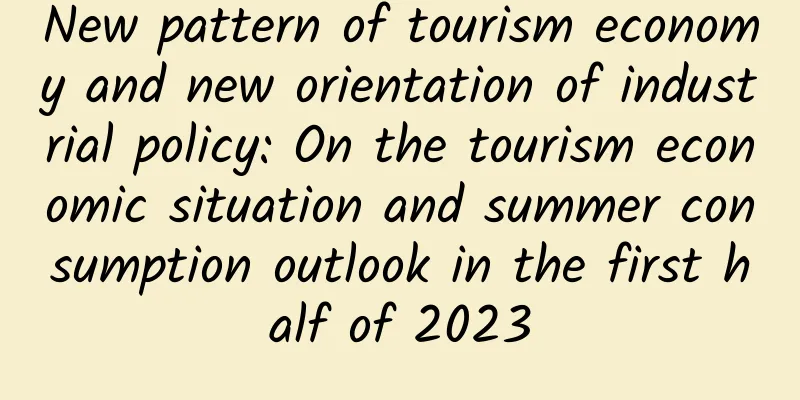New pattern of tourism economy and new orientation of industrial policy: On the tourism economic situation and summer consumption outlook in the first half of 2023

|
01. Economic upturn, market decline and strategic adjustment Affected by multiple favorable factors such as the easing of policies on residents' travel and contact consumption, the steady improvement of the macro-economy, and the central and local governments' multiple measures to promote consumption, the tourism economy in the first half of 2023 has entered a new channel of comprehensive recovery with "high opening and steady progress, strong supply and demand, and accelerated recovery". During the five-day Labor Day holiday, the number of domestic tourists and tourism revenue exceeded the same period in 2019, and the average travel distance exceeded 180 kilometers. The month-on-month and year-on-year data of market indicators, city popularity, and tourist satisfaction during holidays, months and quarters have shown that the tourism economy has ushered in a strategic turning point and entered an irreversible new channel of recovery and upward movement. According to the official website of the Ministry of Culture and Tourism, domestic tourism trips in the first half of the year reached 2.384 billion, a year-on-year increase of 63.9%; domestic tourism revenue reached 2.30 trillion yuan, a year-on-year increase of 95.9%. Whether it is residents' willingness to travel, entrepreneurs' confidence, or the comprehensive prosperity index of tourism economic operation, they have all reached the best level in the past three years. Considering the strong demand during the upcoming "summer vacation" and the National Day and Mid-Autumn Festival holidays, as well as the positive impact of the supply side and policy, we have reason to be more optimistic about the tourism economy in the second half of the year. The China Tourism Academy predicts that the number of domestic tourists will reach 5.5 billion and the domestic tourism revenue will exceed 5 trillion yuan, recovering to more than 90% and 80% of 2019 respectively. Figure 1: Tourism Economic Prosperity Index from 2015Q1 to 2023Q2 In the first half of 2023, the national comprehensive tourist satisfaction index was 80.08, which was in the "satisfactory" range, up 0.32 (0.4%) from the previous month, and basically the same as the level in the first half of 2019 (80.15). Experience shows that if the current tourist satisfaction is stable, the residents' travel willingness and consumption expectations in the next period will be stabilized, and the confidence of investment institutions and market players will be improved accordingly. Figure 2: National Tourist Satisfaction Index from 2014Q1 to 2023Q2 Affected by the rapid increase in demand for research, summer vacation, vacation and health care, the summer vacation of 2023 has received great attention from all walks of life in politics, industry and academia. Netizens are often seen commenting under popular scenic spots and hot news such as Dunhuang, Nalati, and Laojun Mountain, "Am I the only one working?" According to the forecast of the China Tourism Research Institute (Data Center of the Ministry of Culture and Tourism), this summer vacation is indeed the hottest summer vacation in the past five years. It is estimated that the number of domestic tourists in June, July and August will reach 1.854 billion, accounting for 28.11% of the number of domestic tourists for the whole year; domestic tourism revenue will reach 1.2 trillion yuan, accounting for about 27.46% of the domestic tourism revenue for the whole year. Among them, in July and August, when the holidays for primary, secondary and college students are most concentrated, the number of domestic tourists is expected to be 1.331 billion, accounting for 20.18% of the number of domestic tourists for the whole year; domestic tourism revenue will reach 0.86 trillion yuan, accounting for about 19.71% of the domestic tourism revenue for the whole year. Judging from the data, the growth rate of tourism revenue is slower than the number of tourists, but we cannot easily draw the conclusion of "consumption downgrade" from this. In the past, tourism consumption was more reflected in the pull effect of medium- and long-distance travel. Now it is mainly reflected in weekend leisure, short-distance vacation, rural tourism and self-driving travel. With less than 20% of cross-provincial and outbound tourism, tourism consumption presents diversified, three-dimensional and complex characteristics. It is one-sided to simply describe it as upgrading or downgrading. From a technical point of view, on the one hand, the recovery of the tourism market is carried out at a rhythm of low at the beginning and high at the end, short distance at the beginning and long distance at the end; on the other hand, more and more tourists with economic budgets, such as "small town youth", "special forces tourists" and "reverse tourists", while expanding the consumption base, also reduce the per capita consumption of all sample tourists. During the Dragon Boat Festival in 2023, rural residents' travel accounted for 22% of the total domestic travel in the country, the highest proportion in the past five years. People who did not travel before are traveling, and those who used to rely on relatives and friends now live in economy hotels. For them, consumption is not downgraded but upgraded. What we need to pay attention to is whether those who used to stay in five-star hotels are now staying in economy hotels, and whether those who used to buy Universal and Disney Express Passes are now buying regular tickets. It is worth noting that the consumption of tourists in the top ten percentiles of consumption capacity has been steadily increasing. Coupled with factors such as price reductions, free admissions and tourism consumption promotion in tourist attractions, the more objective tourism economic situation is "market sinking, consumption stratification, overall upgrading, imbalanced and insufficient tourism supply and demand, especially insufficient supply of high-quality tourism products." Judging from public information, the policy supply of tourism consumption in the near future will mainly focus on stabilizing consumption expectations, boosting consumer confidence, optimizing consumption structure, expanding consumption scale and improving development quality . To this end, the central government will boost tourism consumption confidence and mobilize social capital investment in the tourism field and the enthusiasm of market entities for entrepreneurship and innovation through high-standard documents, meetings and mechanism innovation on the basis of macro-control policies such as finance, finance, development and land, supply-side structural reform and demand-side expected management. Pay more attention to the innovative demonstration role of the top 20 Chinese tourism groups such as China Travel, OCT, BTG, Lingnan, Hangzhou Business Travel, Kaiyuan, Ctrip and Spring Airlines, pay more attention to the digital transformation of small and medium-sized enterprises, and thus consolidate the micro-foundation for high-quality development of the tourism industry. With the development of China's modernization process and the arrival of the era of comprehensive development of mass tourism, the overall positioning and development strategy of the tourism industry in the new era may be adjusted as necessary. Tourism is a strategic pillar industry of the national economy, a modern service industry integrating the real economy and the digital economy, and a happy cause that meets the people's needs for a better life. We will continue to develop people-centered mass tourism, modernization-oriented smart tourism, sustainable green tourism for the future, and civilized tourism that demonstrates cultural confidence. We will persist in shaping tourism with culture and promoting culture with tourism. We will promote the deep integration of culture and tourism and build tourism into a priority area of humanistic economy and a demonstration industry for high-quality development. 02. Urban agglomeration, block drainage and business integration From the historical process, in the 45 years of reform and opening up, China's tourism has gone through an unconventional development model of "inbound tourism first, domestic tourism second, and outbound tourism third". Today, domestic tourism has become an increasingly stable basic consumer market, and inbound tourism needs a new strategic plan to revitalize it. From the perspective of spatial layout, it is the evolutionary logic of "sightseeing first, then leisure scenes; ancient villages and towns first, then urban blocks; first the west, then the east, and then the middle". With the comprehensive development of mass tourism and the rise of leisure and vacation needs, the focus of tourism work has gradually shifted to cities, and the spatial layout has also begun to shift to the developed eastern coastal areas. The tourism spatial layout of the new era will pay more attention to the construction of tourist leisure cities and blocks while pursuing the effective improvement of the quality and reasonable growth of the quantity of scenic spots and resorts, and pay more attention to the cultivation of national tourist routes based on national parks and national cultural parks, as well as the industrialization of Guizhou tourism, the construction of world-class tourist cities such as Qinghai International Ecotourism Destination and Guilin . The China Tourism Academy (Data Center of the Ministry of Culture and Tourism) clusters the tourism market heat of each province, autonomous region and municipality according to indicators such as the number of tourists, population and effective recreation area in the province, and divides the tourism market heat of each province, autonomous region and municipality from high to low into leading development areas, areas ready to go and relatively lagging areas. Among them, the areas ready to go include 18 provinces, autonomous regions and municipalities, including Henan, Anhui, Chongqing, Sichuan, Yunnan, Hunan, Fujian, Hainan, Hubei, Hebei, Liaoning, Shaanxi, Guizhou, Jiangxi, Guangxi, Jilin, Shanxi and Ningxia. The proportion of domestic tourists received in the country is 60.05%, and the average provincial reception accounts for 3.34%. This region has a large permanent population, great economic growth potential and vast urbanization space. It is the driving force for the growth of national tourism consumption and is also the focus of fiscal, financial, development and reform, land, environmental protection and consumption policies in the current and future period. By releasing the potential of cultural leisure and tourism consumption in medium-heat areas, a new pattern of tourism development space of "the rise of the central region, the rise of the east and the rise of the west" in the new era will be steadily constructed. From the perspective of the city scale, we should promote the linear diffusion and fan-shaped radiation of tourism consumption from hot cities to surrounding areas, and steadily build a new pattern of tourism consumption with "central radiation and peripheral acceptance". Traditional high-heat cities such as Xi'an, Shanghai, Guangzhou, Shenzhen, and Zhengzhou appear frequently and their heat is stable, while emerging hot cities such as Zibo, Shantou, and Xining appear less frequently and for a short time. This means that the heat of traditional high-heat cities is stable, but the heat of emerging hot cities is difficult to maintain. There are only 84 cities in the top 50 in terms of heat every month, accounting for 24.49% of the 343 sample cities, of which 26 cities can enter the top 50 in terms of heat every month, and the structure is very stable. These cities are concentrated in the triangular area with Beijing, Shanghai, and Chengdu as the vertices, as well as the Guangdong-Hong Kong-Macao Greater Bay Area city cluster. Affected by the superposition of multiple factors such as the source, distribution center, and destination of high-heat cities, the heat of their surrounding cities will also show regular fluctuations. The tourism industry policy focuses on guiding destination marketing agencies and travel agents to guide tourists from the main urban areas of high-heat cities to suburbs, remote suburbs, and surrounding provinces and cities. Market players with conditions are encouraged to explore a new tourism economic model of "travel agency attraction, aviation/high-speed rail transportation, and resort consumption", thereby expanding the ability to deliver long-distance customers. Figure 3: Frequency of the top 50 cities in terms of tourism popularity nationwide (January-June 2023) From the perspective of the block scale, we should implement the development concept of host-guest sharing, implement the business-tourism integration plan, promote the spread of passenger flow from the main urban area and main blocks to the auxiliary streets and back streets, and effectively expand urban tourism consumption. The China Tourism Academy (Data Center of the Ministry of Culture and Tourism) has long conducted grid tracking research on the recreational trajectories of urban tourists. The data shows that the grid points of tourist trajectories are highly concentrated in the local major business districts, blocks and urban leisure areas. The top five corresponding blocks or business districts in Nanjing are: Xinjiekou Business District, Nanjing Confucius Temple-Qinhuai Scenic Belt, Caochangmen Business District, Zhongshan Scenic Area and Nanjing Muyan Riverside Scenic Area. Through the analysis of base station load within the grid, it is found that tourists in specific blocks and business districts mainly contact the base stations on the main streets, but the base station load levels of auxiliary streets or back streets are relatively low. This means that even in the main urban areas of central cities, tourist trajectories and tourism consumption are unbalanced. Consumption policies in the new era should use modern technologies such as artificial intelligence, big data, and 5G communications, combined with commercial outlets and traffic planning layout, to effectively guide the spread of urban customers from main streets to back streets, from main business districts to secondary business districts, and from central leisure areas to community cultural spaces. 03. Project construction, scenario reconstruction and investment guidance After this epidemic, the tourism industry can no longer return to the traditional model of "reaping dividends from huge crowds of people and charging admission fees for enclosing mountains and waters". Natural resources and historical and cultural resources have shown signs of diminishing marginal effects. Science and technology, culture, art, education, entrepreneurship and innovation are becoming new driving forces for the development of the tourism industry. With the cross-border entry of industrial capital and the digital transformation of traditional market players, the tourism economy is steadily entering a virtuous cycle of "quality demand guiding supply innovation, and innovative supply creating demand upgrades". Tourism industry policies will pay more attention to implementing the new development concept of innovation, coordination, greenness, openness and sharing, adhere to the principle of shaping tourism with culture and promoting culture with tourism, promote the deep integration of culture and tourism, and build a new development pattern of effective improvement in quality and reasonable growth in quantity. Mass tourism has entered a new stage of all-round development, with more obvious consumption characteristics of personalization, quality and diversity, and more diverse consumption scenarios. Tourists want beautiful scenery and a better life. Tourist destinations have become a new space for a better life where "near and far are attracted, and hosts and guests share". New tourism demands such as self-driving tours, RVs, ice and snow, summer vacations, winter escapes, night tours, health care, study tours, vacations, sports, food, exhibitions, music festivals, and concerts have moved from the concept introduction stage to the market practice stage. Tourism consumption has moved from the concept of destinations to a new pattern in which both destinations and source areas are given equal importance, and before, during and after the trip are connected. Promoting more infrastructure and public services into the tourism industry and encouraging innovations in travel service providers, tourism suppliers, and small transportation modes at destinations will be the policy orientation for promoting tourism consumption and promoting high-quality development of the tourism industry. Create more new tourism experience scenes such as humanities, science and technology, and research and study. Tourism consumption promotion cannot simply focus on free tickets, price cuts, and subsidies. We must pay more attention to the travel markets such as youth research and study travel, middle-aged and elderly travel and health care, and rural residents' sightseeing and leisure, and launch products that meet their consumption preferences and payment capabilities. It is necessary to systematically sort out the geological features, animal and plant resources, and historical context of national parks and national cultural parks, coordinate government, social and market forces, and make the cultural relics collected in museums, the heritage displayed on the vast land, and the words written in ancient books come alive. Pay more attention to the creative inheritance and innovative development of excellent traditional culture, and rely on the Chinese dream of national rejuvenation and people's happiness to provide tourists with excellent literary and artistic works, high-quality tourism products, and more futuristic quality leisure space. Increase the publicity and promotion of domestic tourism, so that the Chinese people can walk freely on the beautiful land, appreciate the magnificent beauty of mountains and rivers, and understand the beauty of culture. Pay attention to the cutting-edge trends of science and technology, education, and economic and social development, and guide youth tourism to pay attention to the current life and the future of human civilization with a broader international perspective. To this end, the tourism industry policy of the new era should focus on promoting the coupling of tourism with various industries of the national economy and various undertakings of social development . Traditional industries such as travel services, accommodation, and entertainment have become more refined, and characteristic homestays, theme hotels, youth hostels, camping, etc. have occupied an increasingly large proportion in the accommodation industry. Tourism and leisure complexes such as cultural and commercial tourism, agricultural and cultural tourism have long been investment hotspots, and new formats such as health tourism, industrial tourism, and sports tourism have also been well developed. Immersive performances, light and shadow shows, drone performances, smart theaters, etc. supported by advanced technology have become the new favorites of the market. A large number of peripheral enterprises such as production service companies, equipment manufacturers, and technology solution providers have emerged around the core needs of the cultural and tourism industries. 04. Individual traveler demand, diversified supply and modernization of governance capabilities The development of free travel and self-guided tours has allowed more and more tourists to enter the production and living space and leisure scenes of residents. Tourist destinations are increasingly characterized by high-quality living spaces that attract visitors from near and far, and are shared by hosts and guests. The tourism market has formed new demands such as food tourism, RV tourism, and characteristic homestays that are sufficient to support business innovation, centering on the personalization, quality, and diversity of eating, living, traveling, shopping, and entertainment. Catering consumption accounts for a high proportion of tourism consumption, and has long remained above 20%. 90% of tourists will try the local specialties after arriving at their destinations. For popular tourist cities such as Chengdu and Changsha, specialties are an important attraction. The pursuit of food even extends to the vegetable market. In some places, the vegetable market has become an important choice for tourists to experience the local lifestyle because it is beautiful, fun to visit, and fun, especially with a "smoky atmosphere". Theoretical research, data analysis and market observation increasingly point to the fact that the tourist experience not only depends on traditional travel service providers, but is also closely related to local life service providers, infrastructure, business environment, public services, etc. The traditional tourism development model based on teams and sightseeing, as well as the corresponding industry supervision methods, are facing the pressure of fundamental changes. The tourism department cannot only focus on travel agencies, tour guides, star-rated hotels, A-level scenic spots and resorts, but should focus on whether tourists are satisfied, whether market entities are competitive, and whether tourism development momentum is new . It should comprehensively promote organizational changes, technological innovation, and the construction of cadres and talent teams to build a new system of high-quality development of the tourism industry in the new stage of comprehensive development of mass tourism. Only when tourism supply, market innovation, and industry supervision are closely related to the good life of the people can the tourism economy ensure sustainable prosperity and development. Although the country's determination to develop inbound tourism has never wavered and its confidence has never dissipated, it is still an indisputable fact that the status of inbound tourism in the tourism economic system and the global tourism market has declined relatively. Establish a tourism coordination and deliberation mechanism at the central level and increase external publicity and tourism promotion efforts. Issue an inbound tourism revitalization plan, focusing on improving the shortcomings of inbound foreigners' tourism experience. All localities and departments should work in the same direction. Key tourist cities should work hard on updating the tourism image, external promotion, and market promotion, enhance the city's visibility and reputation, and make great efforts to improve the tourism consumption environment. Simplify the fingerprint visa policy, orderly restore and expand the visa on arrival and visa-free policies, increase the efforts to restore flight routes, and increase the entry facilitation services of payment, hotels, and scenic spots and resorts. Based on the actual needs of inbound tourists such as cultural experience, travel preferences, and dining habits, optimize inbound tourism products and routes. Strengthen the training and policy support of tour guides, especially foreign language tour guides, especially tour guides of small languages. Author | Dai Bin Proofreading | Yang Liqiong Source | China Tourism Academy (Data Center of the Ministry of Culture and Tourism) |
<<: NRF: 2022 U.S. Retailer Rankings
>>: How big is the e-commerce market potential in this Middle Eastern country?
Recommend
What are the functions and effects of walnut wood?
The medicinal value of walnut wood is relatively ...
The efficacy and role of the horse hoof lotus [picture]
Traditional Chinese medicine has always been the ...
Seriously, it’s better to throw your underwear and socks into the washing machine than to wash them by hand!
When you are busy at work, you will inevitably wa...
Does the early blooming of cherry blossoms indicate climate and ecological crises?
The cherry blossom season has arrived again. Moni...
Mulberries are so delicious, so why can’t we plant mulberry trees in front of our houses?
When talking about mulberry trees, most people th...
What are the effects of Schisandra chinensis?
Schisandra chinensis is a common Chinese herbal m...
Want to eat all the crayfish? First figure out: where are you eating crayfish from?
Recently, although the temperature has repeatedly...
Is it okay to not drink "big alcohol"? A survey of 9.78 million people found that "regular drinking of small amounts of alcohol" is more harmful
In social situations, people often say "it&#...
When birds fly south, which “South” are they heading to?
Author: Yunhai Science Popularization The article...
Does your toilet smell like rotten eggs? Be careful!
If you smell a pungent smell of rotten eggs in th...
The efficacy and function of vinegar bupleurum
There are many kinds of diseases in daily life, a...
China's longest wooden arch bridge burned down and collapsed. What are the key points of fire prevention for cultural relics and ancient buildings?
Sad! Wan'an Bridge, the longest existing wood...
Effects and functions of hibiscus flowers
Hibiscus flower is a kind of traditional Chinese ...
Zhishixiaopi Pills
People's living standards are getting better ...
The efficacy and function of poplar root bark
Poplar root bark is a common Chinese medicine wit...









